From the royal table: culinary preferences of Russian emperors
Categories: Food and Drinks | History
By Pictolic https://pictolic.com/article/from-the-royal-table-culinary-preferences-of-russian-emperors.htmlWhat did the Russian emperors like to eat? In this issue, you will learn about the gastronomic preferences of the heads of the Russian Empire — from Alexander I to Alexander III.
In general, it can be argued that the Russian autocrats, starting with Catherine II, were quite moderate in food. Quite often, their everyday table was distinguished by simplicity, although this, of course, did not exclude gastronomic delights during public fristies (breakfasts), lunches and dinners.
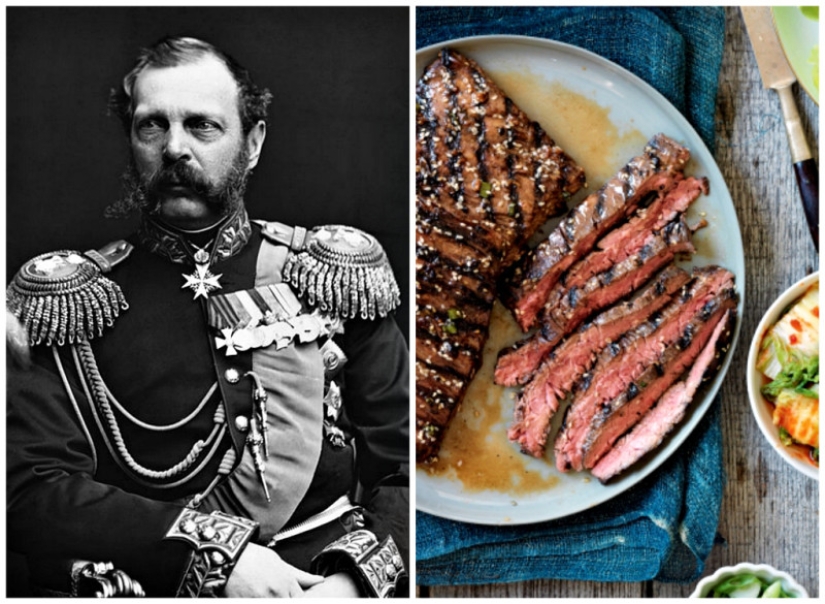

Emperor Alexander I (1777-1825) and the pozharsky cutlets that appeared thanks to him
The memoirists brought to us the" gastronomic daily routine " of Emperor Alexander I. A very competent person, a life doctor D. K. Tarasov, writes about this side of the tsar's life, who, without any doubt, recommended certain dishes to the tsar, taking into account the peculiarities of his body:
It is safe to say that green tea in the morning and yogurt with prunes at night are the recommendations of doctors who were responsible for the normal digestion of the king. But strawberries and prunes without skin are the gastronomic preferences of the emperor.

Tea service of Emperor Alexander I.
Fruit on the imperial table in the winter season was quite common. These fruits and berries were regularly supplied not only from greenhouses in Tsarskoye Selo, Gatchina and Ropsha. They were taken to St. Petersburg and from the Moscow imperial greenhouses. For members of the imperial family, there were some unspoken "quotas" for the fruits supplied. And when fruits were sent from the imperial greenhouses to the table of a dignitary, it testified to his special proximity to the imperial family.
Among the national gastronomic preferences of Alexander I, memoirists mention botvinya: "The emperor Alexander Pavlovich was very well disposed to the English ambassador. Once, when talking to him about Russian cuisine, he asked if he had any idea about botvinya, which the emperor himself loved very much."
In this quote, the very fact of "gastronomic conversations" between the Russian emperor and the English ambassador at a social event is noteworthy, that is, this topic was considered quite "secular". This conversation had a rather comical continuation. When Alexander I sent the English ambassador the botvinya he loved so much, it was served warmed up to the table. It is clear that it was no longer Botvinya. And when the emperor asked about the ambassador's "impressions" of this dish, the diplomat found himself in great difficulty…

Botvinya.
Sometimes the gastronomic preferences of the autocrats, taking into account the peculiarities of the time, posed some danger to their health. For example, Alexander I liked tea with honey. The matter is completely ordinary, useful and harmless. However, the tastes of the emperor somehow became the tastes of his entourage, and tea with honey is known to be a good diaphoretic. When, among other things, tea with honey was served in silver bowls during the balls, the low-cut ladies who danced in the halls and enfilades of the Winter Palace, where drafts sometimes walked, willingly ate it and then often caught a cold. Therefore, the court doctors recommended to exclude this treat from the menu.

The Imperial Ball (Mihai Zici).
Alexander I traveled a lot in Europe after the Napoleonic Wars. He tried not to burden his motorcade with cooks and wagons with provisions and made do with the kitchen that he came across on the way. However, later, for sanitary reasons, this practice gradually disappears, and from the second quarter of the XIX century, the emperors, if possible, ate "their own" on the road.
Despite all the unpretentiousness in food, it is with the name of Alexander I that the appearance of the famous Pozharsky cutlets is associated. According to legend, the emperor stopped to eat at Pozharsky's tavern in Torzhok during his next trip to Moscow. The menu included veal chopped cutlets, which were exactly what the emperor ordered. However, Pozharsky did not have veal. In order to avoid embarrassment, he ordered an urgent preparation of chicken fillet cutlets. The tsar liked the cutlets so much that he asked about the recipe for the cutlets, calling them "pozharsky" after the innkeeper. This random "know-how" is loved by many to this day.
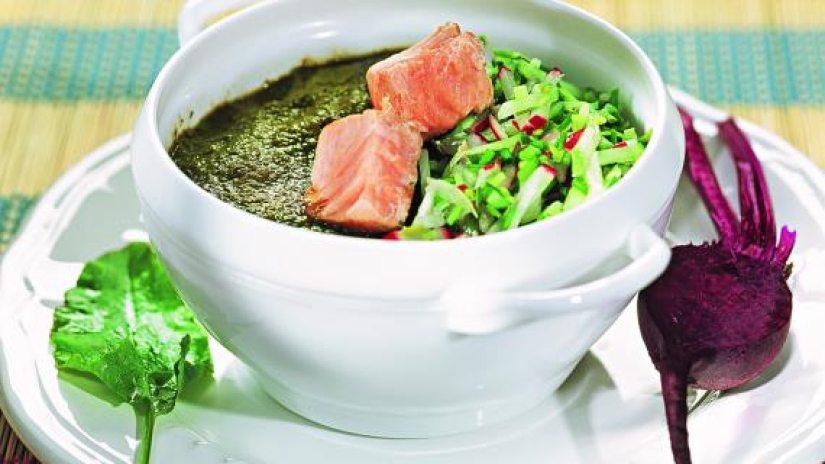
It is noteworthy that such a traditional daily routine on the noble table, as grainy, powdered or ketov caviar, began to penetrate into Europe precisely under Alexander I. At first, foreigners looked at caviar as an exotic "Russian" product. The first Consul Bonaparte, to whom Count Markov sent grainy caviar, received it from his kitchen cooked: the Russian table at that time was little known in foreign lands.
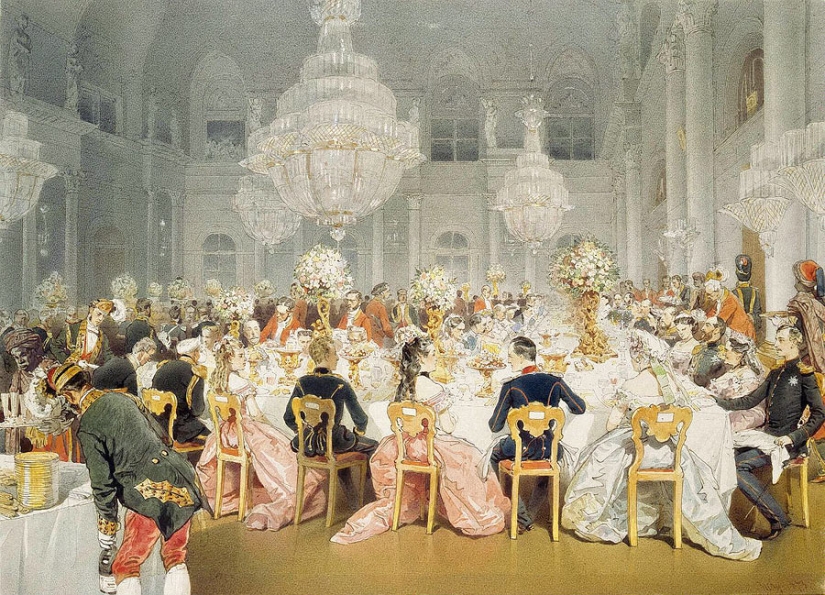
Nicholas I (1796-1855) and his favorite cabbage soup (cabbage soup)
Unlike his older brother, Nicholas I did not like strawberries for breakfast, but pickles. And in general, many people considered him a champion of a healthy lifestyle.
Memoirists with one voice emphasize the culinary unpretentiousness of Emperor Nicholas I. The French artist O. Vernet, who traveled to Russia with the emperor in 1842, wrote to his family: "The Emperor is a great teetotaler; he eats only cabbage soup with lard, meat, a little game and fish, as well as pickles. He drinks only water." As for the "pickles", many of his contemporaries mentioned that the tsar really liked pickles. According to the vedomosti of 1840, five pickles were to be served to Nikolai Pavlovich every day in the morning.
He loved buckwheat porridge, which was served to him in a pot. The emperor was not particularly fond of expensive fish delicacies and game. In the last years of his life, Nikolai Pavlovich preferred vegetable dishes, mashed potato soup and compote. There is no doubt that the" German " soup from mashed potatoes was prescribed to the tsar by his life-physician consultant M. M. Mand, he was the first to introduce therapeutic fasting "at the highest level"into medical practice.
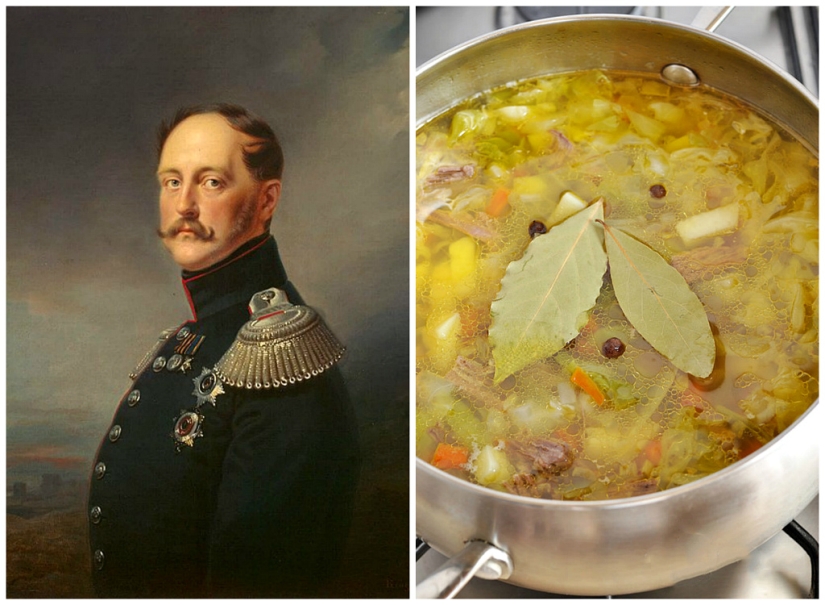
Mashed potato soup.
As follows from the archival documents, the usual breakfast of Nicholas I was as follows. Early in the morning, Nikolai Pavlovich was "eating tea"in his office. It was accompanied by a" fryshtik", that is, a breakfast consisting of sweet and sour bread, two round rolls and crackers. The emperor avoided any spices. The emperor's daily allowance also included treating the speakers who visited his office. The treat was quite modest and included: refined sugar ("refinad") 2 pounds (819 g, counting in the Russian pound 409.5 g), black and green tea "heirloom", that is, the best firms, 18 spools (97 g, counting in the spool 4,266 g), Lebanese coffee 3/4 pounds (103 g), as well as cream, various rolls and pretzels (sweet, sugar, with anise, with salt), "vitushki" and "sticks".
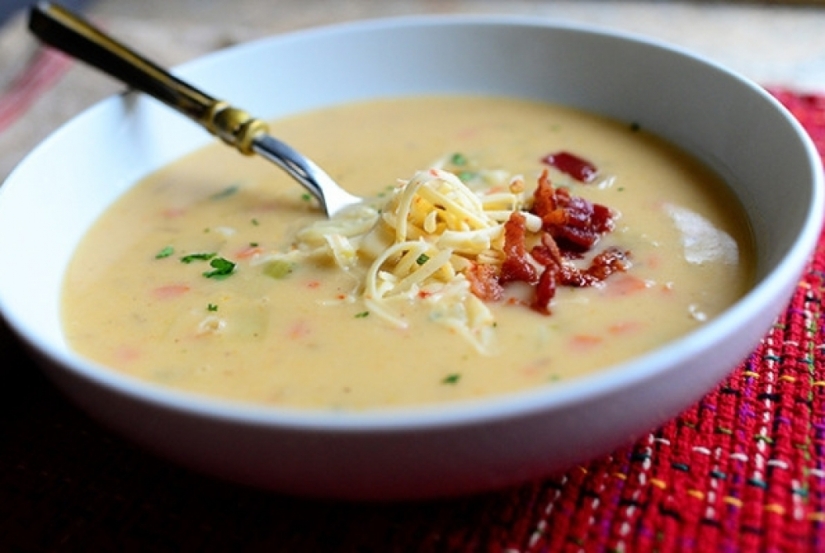
At Easter, cakes were served in the imperial office, and morning pancakes were served on Shrovetide.
For the workaholic Nicholas I, everyday dinners sometimes became a continuation of the working day, since two or three persons close to the tsar were invited to them. At the dinners, "in a narrow circle", without outsiders, various "working issues" continued to be discussed in an informal atmosphere. This is another feature of the emperor's daily life.
A very authoritative biographer of Nicholas I claims that the tsar " ate moderately at lunch, often a piece of black bread for dinner." Another memoirist, confirming the tsar's abstinence in food, writes that he " never had dinner, but usually drank two spoons of cucumber pickle when carrying pickles." Also, since the time of Nicholas I, rolls have entered the household, they were eaten hot, in a heated napkin. To prepare these rolls, Moskvoretsky water was delivered to the tsar's kitchen in special tanks. One of the memoirists mentions the name of the head waiter Nicholas I. It was a certain Miller, to whom the tsar ordered "that he should never have more than three dishes at dinner, which was resolutely carried out."
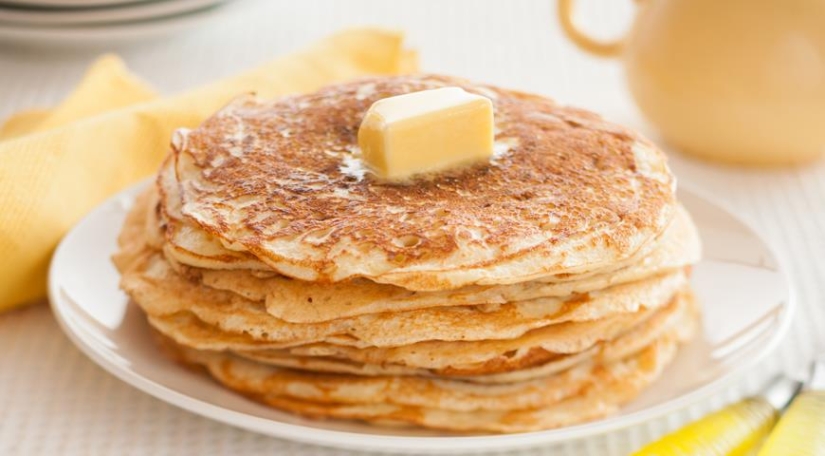
Rolls.
Like any other person, the emperor loved to eat ice cream in his childhood. However, when the doctors forbade the younger brother of Nicholas I, Grand Duke Mikhail Pavlovich, to eat ice cream, Nikolai refused his favorite delicacy as a sign of solidarity with his brother.
For all the above-described culinary unpretentiousness of Emperor Nicholas I, the generally accepted Anglo-French cuisine prevailed during ceremonial dinners. A. S. Pushkin described this "typical" table of the second quarter of the XIX century in the immortal "Eugene Onegin" :
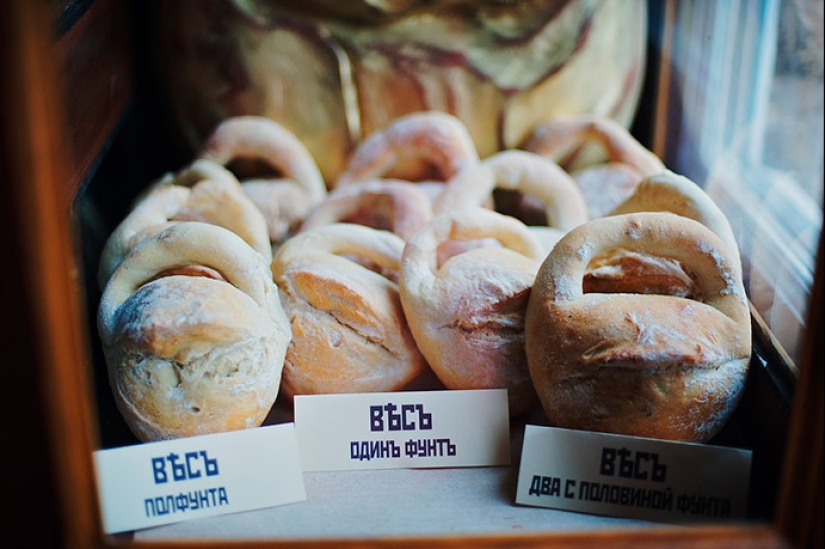
Strasbourg pie.
As already noted, when traveling around the country, the emperors could well have a snack in a tavern with a good reputation. And despite the gradual abandonment of this practice for regime reasons, periodically such episodes were repeated, if not for the emperors themselves, then for their loved ones.
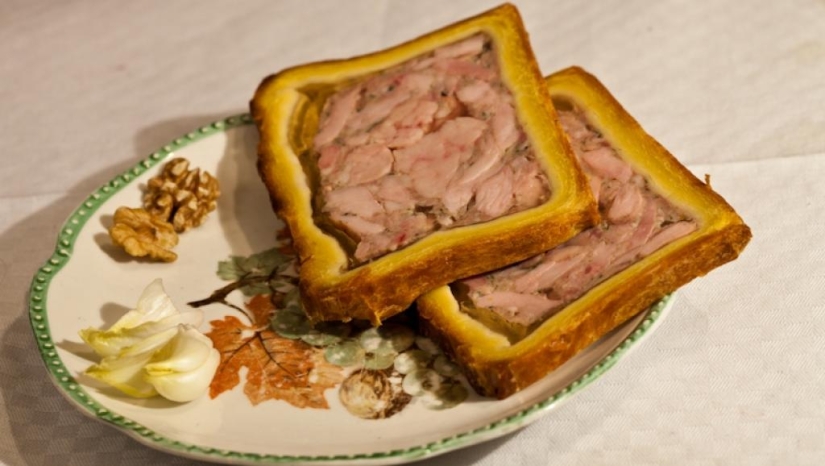
Guryev porridge.
In such inns, the emperor could enjoy the gastronomic "hits" of his era. For example, Guryev porridge. As follows from the historically fixed name of the porridge, its name is associated with the name of the Minister of Finance, Count D. A. Guryev. His track record is very solid, but today few people remember Count Dmitry Alexandrovich Guryev (1751-1825) as a statesman and Minister of Finance. They remember him exclusively as a person whose name is the famous porridge. Although in fact, the authorship of porridge does not belong to him at all. The famous porridge was invented by the serf cook Zakhar Kuzmin — the "property" of the retired major of the Orenburg Dragoon Regiment Georgy Yurisovsky, with whom Guryev was staying. Subsequently, Guryev bought Kuzmin and his family and made him a full-time cook of his yard. Although there is a very unreliable version that the author of the recipe for the famous porridge is Guryev himself.

Alexander II (1818-1881) and meat on coals
Alexander II, unlike his father, adhered to refined European traditions in the menu. In addition, Alexander II, as a passionate hunter, greatly appreciated hunting meals in the fresh air after hunting.
As a rule, peasants and retired soldiers from nearby villages gathered around the hunters having breakfast. The emperor could accept the petition or order the official with the "royal box" to give the peasants a ruble each, and the knights of St. George — three.
The eyewitness's story can be illustrated with cards from the "Hunting Deck" of the court artist M. Zichi, who repeatedly participated in such hunts. On the maps, he drew the plots of one of the winter hunts of 1860. In one of the drawings, moose came up to the table being set, and the palace waiters are fighting off "uninvited guests" with frying pans. In another picture, the respectable generals of the retinue decided to eat at night in a very Russian way, began to heat the pasta themselves in the kitchen and, of course, burned them. It should be noted that in the second half of the XIX century, pasta was quite expensive and, as a rule, was imported from Italy (although the first pasta factory in Russia was opened in Odessa at the end of the XVIII century).
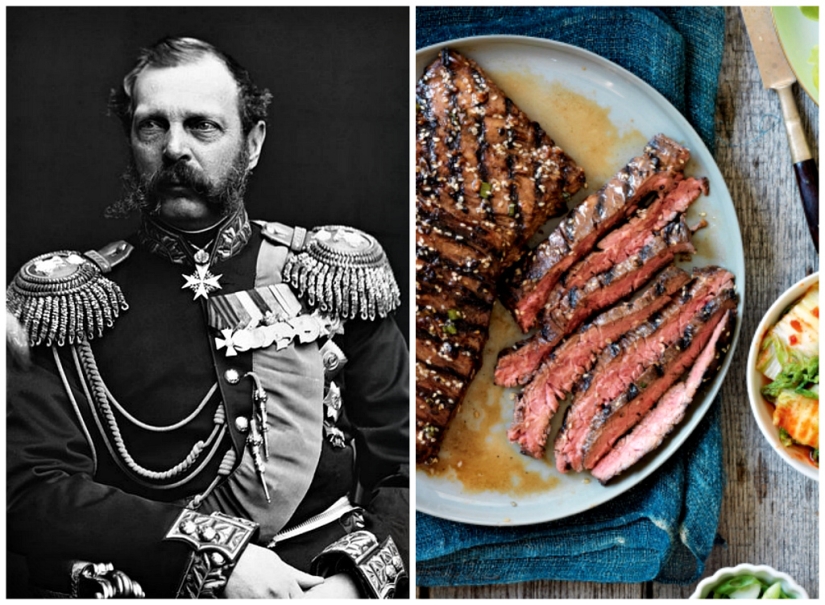
Zichi maps.
Despite the marching entourage, the tables "on the hunting plein air" were covered with starched tablecloths, porcelain plates, crystal decanters with drinks and plates with snacks were placed on the table. A picture has been preserved where the Grand Duke Nikolai Nikolaevich (St.) has a snack on one of the hunts. Everyone, including the emperor, ate standing or sitting on a stump, holding plates on their knees. During these meals, Alexander II liked to taste a piece of bear meat or bear liver cooked on coals.
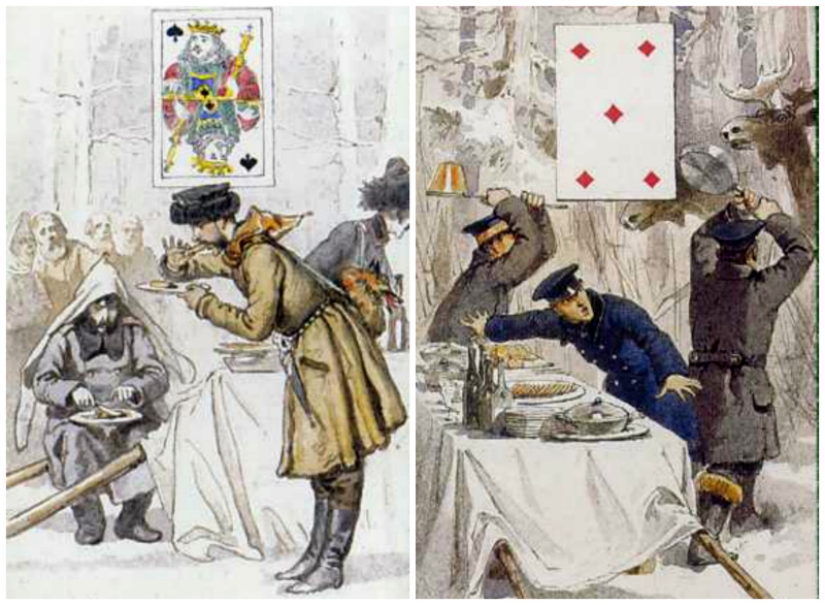
Bear meat on coals.
After the end of the hunt, already in the residence, a table was set, which was served with fresh meat of the killed game. As a rule, the court hunting orchestra of 20 people played during lunch.
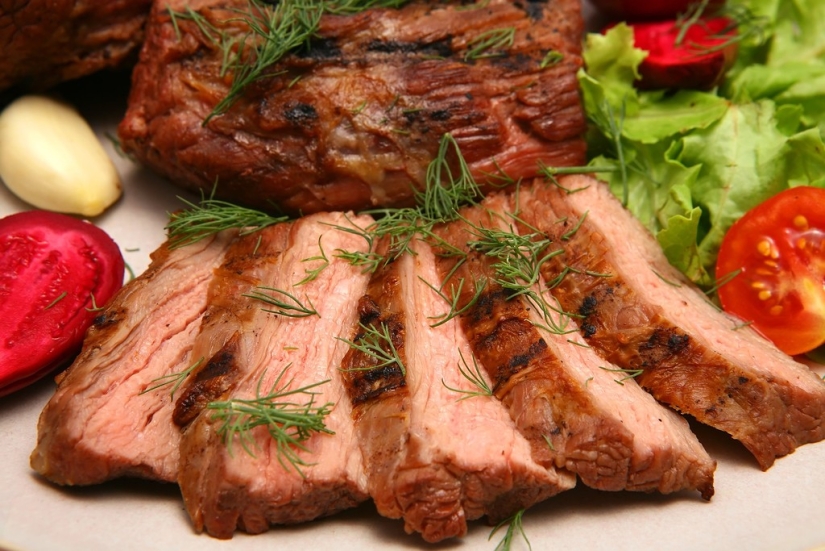
Maria Alexandrovna, about 1860.
In his younger years, Alexander II, then still a tsarevich, spoiled his wife. By his order, in the autumn, an apple tree with fruits was placed in a tub in the dining room on the tsarevna's half, so that Maria Alexandrovna herself could pick the apple she liked. In the spring, they put baskets with the first strawberries and other berries. However, then the pampering ended, the fruit began to be sent to another person…

Alexander III and okroshka on sour milk, as the emperor loved
But the most exciting will be the story about the culinary preferences of Alexander III. Since the emperor loved and ate delicious things, and even, like many, sometimes at night.
Yes, Alexander III struggled with excess weight, because he believed that the shapeless, fat emperor discredited the usual handsome appearance of the Russian autocrat. But, like all losing weight, sometimes he broke down and tried to eat at an untimely time. This problem was solved by the valets. For example, in the Gatchina Palace, a washbasin, two samovars and a saucepan with a stand on which the valets could warm up something for the emperor "quickly" were stored in a room behind the personal chambers of Alexander III. There are memoir mentions that the already seriously ill emperor, who was on a dairy diet, periodically asked to bring him the simplest soldier's dishes from the guard barracks.
A lot of memoirs and various culinary stories from the reign of Alexander III have been preserved. If we talk about his culinary preferences, then, according to contemporaries, the tsar was moderate in food and loved a simple, healthy table. One of his most favorite dishes was a pig with horseradish "from Testov", which was necessarily ordered during visits to Moscow.
The famous writer of old Moscow V. A. Gilyarovsky in his famous book "Moscow and Muscovites" mentioned that " the St. Petersburg nobility, led by the grand dukes, specially came from St. Petersburg to eat a testovsky pig, cancer soup with rasstegayami and the famous Guryev porridge."
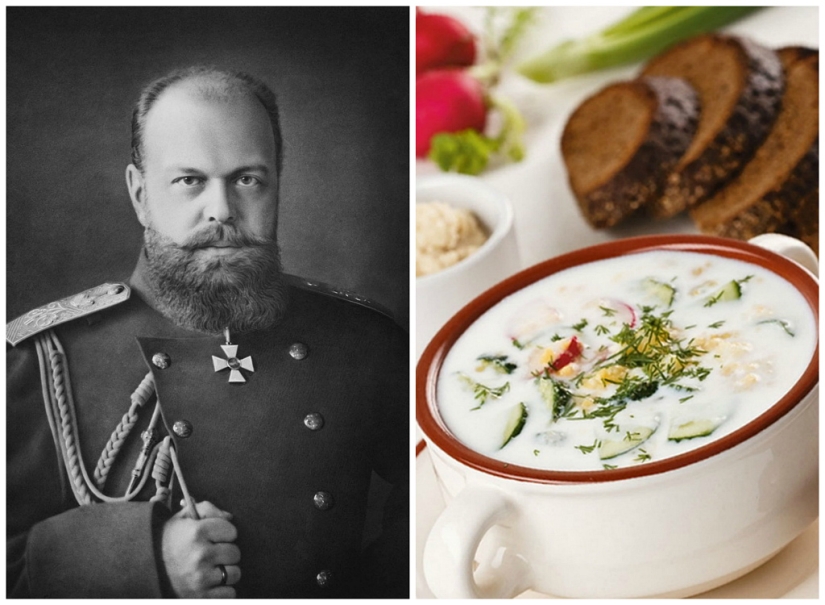
Stuffed testovsky piglet.
At the same time, it is absolutely not necessary to simplify the gastronomic preferences of Alexander III. A good table with thin and varied dishes is quite common in imperial palaces, but the "merchant" piglet under horseradish was a rare exotic in the style of "a la russe". However, apparently, the combination of thin sauces and "common" dishes was the characteristic gastronomic style of the emperor. So, one of the people close to the tsar mentioned that "he loved Cumberland sauce very much and was always ready to eat pickles, which he preferred in Moscow." Apparently, Cumberland sauce and pickles were organically combined for the tsar. Judging by the memoir mentions, Alexander III really liked spicy sauces. He loved him so much that he could thank him with a "kind telegram" for "some particularly delicious sauce brought to him by Vladimir Alexandrovich from Paris."
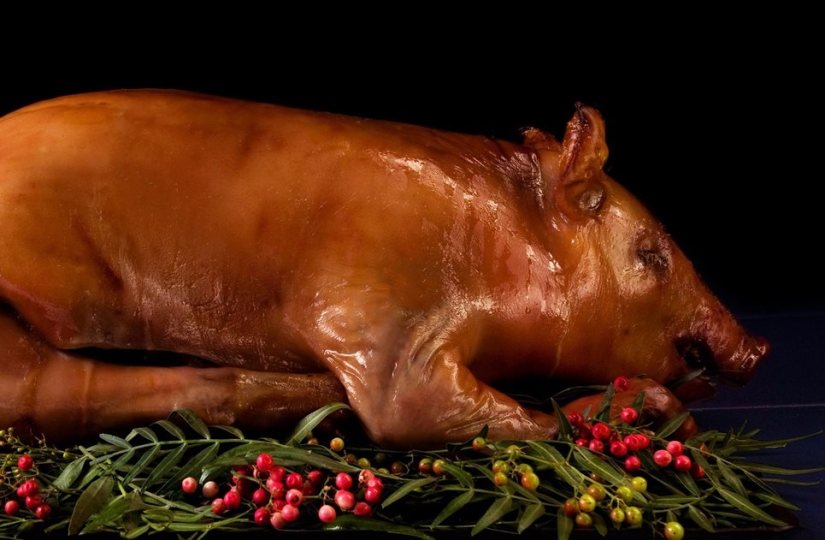
Cumberland sauce.
This famous sauce was reproduced with varying success by several generations of court maitre d'. For example, Cumberland sauce was served at a gala dinner in 1908 (in Revel) during the meeting of Nicholas II with the English King Edward XVIII. According to the memoirist, " the dinner was very lively… When a wild goat with redcurrant sweet jelly was served with an amazing Cumberland sauce, a famous deli (meaning the English king — - I. Zimin) He praised: "You can eat your own mother with this sauce."" Pierre Kyuba, the head waiter, was very pleased.
It should be noted that the culinary preferences of Alexander III remained a mystery even for dignitaries very close to the tsar. What was served during the festive meals was a high-quality version of the restaurant menu. And what the tsar ate did not go beyond the usual, very high, but standards.
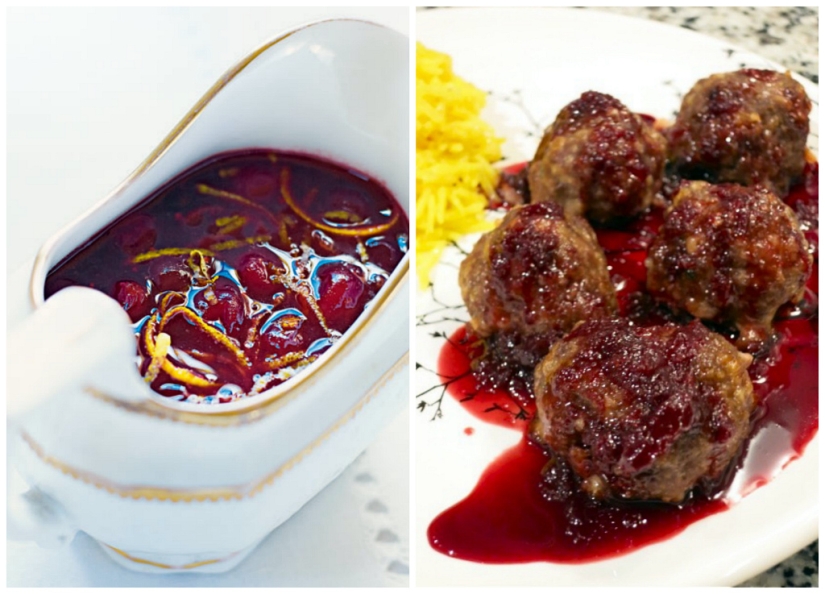
Dessert table (exposition of the Arkhangelsk Museum).
In 1889, during military exercises, Alexander III lived for several days in the country house of the Secretary of State A. A. Polovtsev. Among other things, the owner was concerned about the preparation of the menu for these few days. And although Polovtsev repeatedly visited the meals in both the Winter and Anichkov palaces, he was extremely puzzled by the search for the emperor's favorite dishes. With this question, he turned to Count S. D. Sheremetev, since he had already received the tsar in his village. When asked what Alexander III's gastronomic preferences are, S. D. Sheremetev answered: "Sour milk, yes, perhaps nothing else," adding that the Empress Maria Feodorovna has no gastronomic preferences.
Alexander III willingly ate fish. Fish was especially often cooked during holidays in Finnish skerries. This is quite understandable, since it was there that the king often fished, and the fish he got, of course, was served to the royal table. It is clear that the fish caught by yourself is especially delicious. During the holidays in Finland, the royal family was surrounded by the most modest number of courtiers, and the family tried to lead a lifestyle of "ordinary people". Maria Fyodorovna personally fried flounder, the emperor's favorite delicacy.
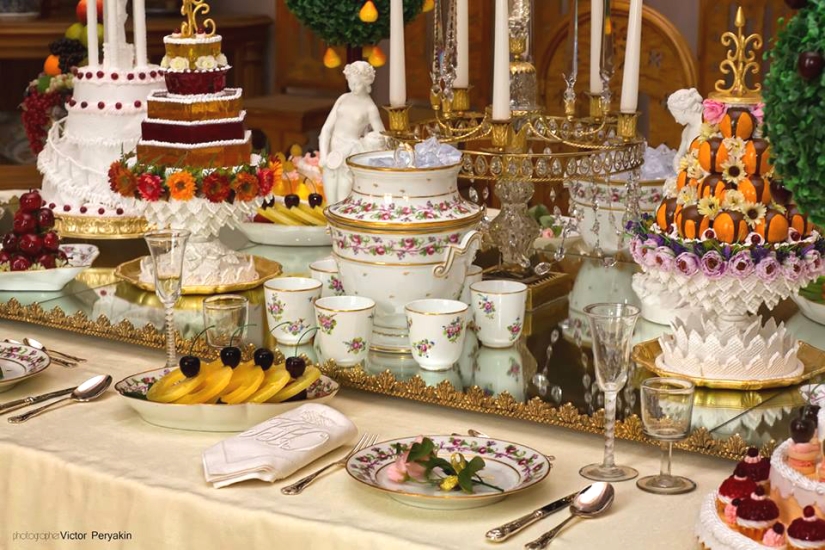
In his younger years, Alexander III liked sweet pastilles and fruit mousse. He liked to drink hot chocolate at the end of breakfast.
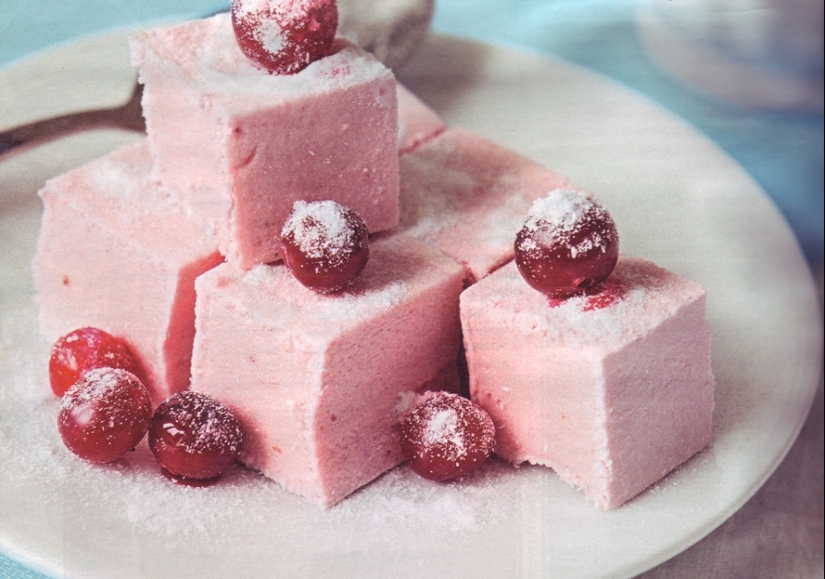
Cranberry paste.
The quality of the chocolate, which was prepared specially for him, often did not suit the tsar: "The sovereign tasted it and abruptly pushed the cup away. "I can't get," he said to Zeddeler, " to serve me decent chocolate." It is difficult to say with what he compared the quality of the delicacy served.
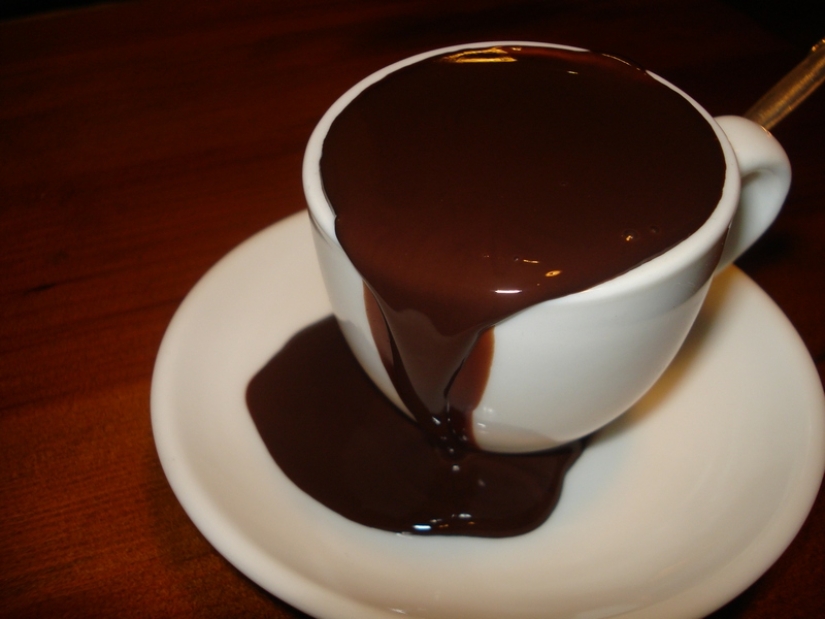
Hot chocolate.
It should be noted that the royal "irritation" at the table could arise for a variety of reasons. So, during one of the breakfasts, the emperor " threw a fork, surprised by the ugliness of its shape." He also had "diplomatic stories" with cutlery. For example, at one of the "diplomatic breakfasts", when the Austrian ambassador dropped that in response to the exercises of the Russian army, Austria would move several army corps to the borders of Russia, Alexander III very prudently flared up. He rolled up his fork with a corkscrew and, throwing it in the direction of the Austrian ambassador, added: "Here's what I'll do with your hulls."
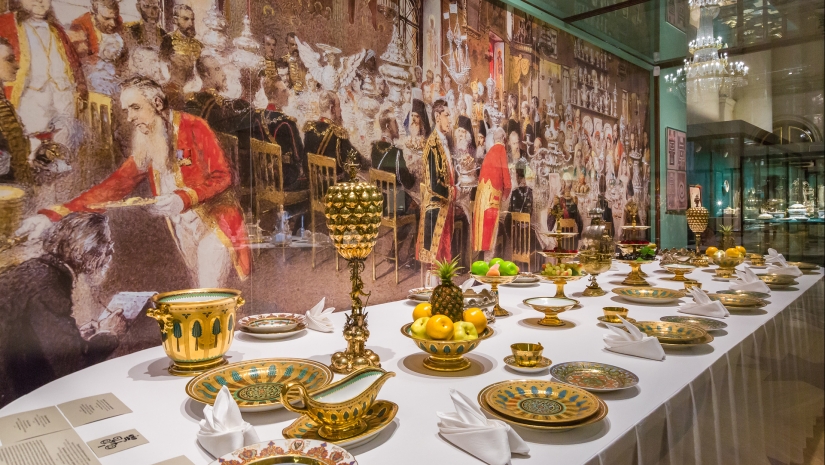
Serving the imperial table. Photos from the exhibition in the Nikolaev hall of the Winter Palace.
The emperor was a hospitable, but diligent host. So, he periodically did not disdain to personally check the bills and lunch calculations of the Marshal's department. In the Gatchina Palace, dinners were held on the first floor in the Arsenal Hall near the stage and the children's wooden mountain. As a rule, the dinners were accompanied by music. The lunch menu consisted of two parts: on one half they printed a culinary menu, on the other — a musical menu. After lunch, the usual "cercle" (fr. "circle") took place. The Empress Maria Feodorovna kindly bypassed everyone. The emperor offered to smoke and choose the alcohol to your taste.
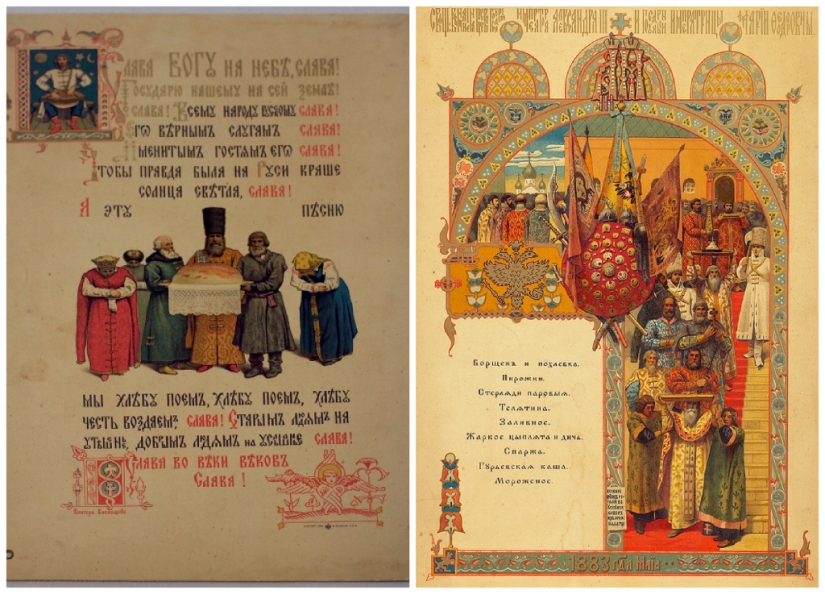
Vasnetsov V. M. "The menu of the ceremonial dinner of Alexander III".
During his trips, outside of the iron rules and traditions of the imperial residences, Alexander III could afford some culinary liberties, which were considered outright bad manners in the palaces. So, during a trip to the Caucasus in the autumn of 1888, the emperor was happy to taste dishes of Caucasian cuisine, regardless of the fact that there are a lot of onions and garlic in them: "The sight of onions and garlic delighted him, and he diligently began to eat it.
The Empress was worried, she could not stand garlic and reproached the Emperor for setting a bad example." Perhaps that is why the court artist M. Zichi depicted Alexander III having breakfast alone in the watercolors of the "Caucasian series" of 1888. In the background, the Empress is sitting, also having breakfast at a separate table. I didn't find her, I found another one.
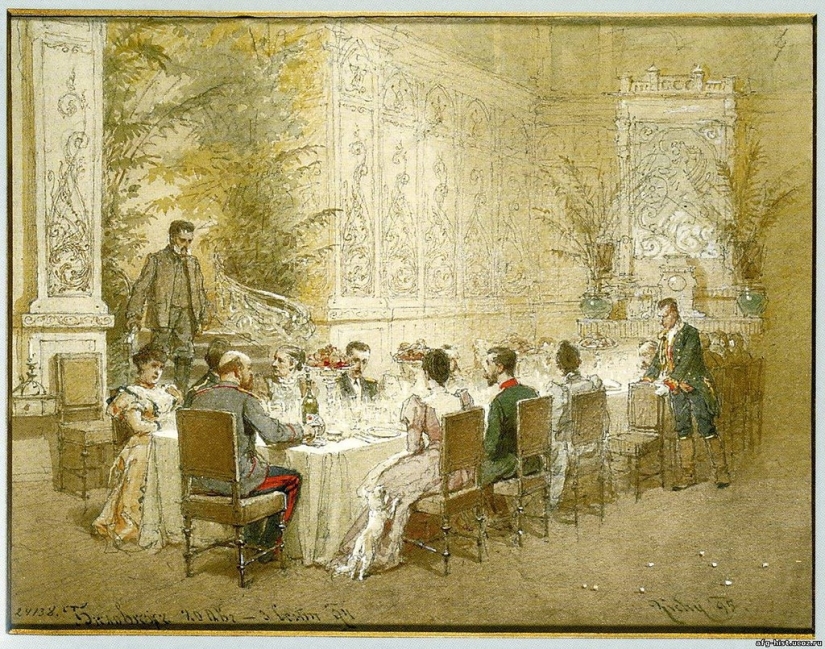
Dinner of the family of Alexander III (M. Zichi).
You can give a few menus from this trip. It can be seen from them that European cuisine prevailed during the festive receptions. For example, on September 19, 1888, during a trip to the Caucasus, Alexander III was offered okroshka, pea soup, pies, cold sturgeon with horseradish, pulada with mushrooms and strawberry ice cream.
At a breakfast with officers and a deputation in Vladikavkaz on September 20, the table was served: okroshka, American-style soup, pies, cold cutlets from sevryuga, bordelaise, fillet of pheasant sauvignon, beef tenderloin with mashed mushrooms, compote of pears on champagne. And on September 26, 1888: okroshka, count's soup, cake, cold sturgeon, partridges with cabbage, lamb saddle with garnish, pears in jelly.
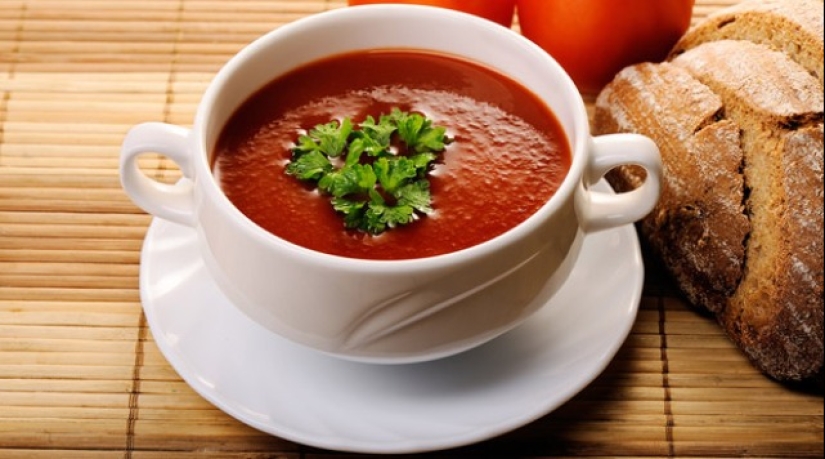
Bordelaise sauce (Bordeaux sauce). It consists of wine (red or white), demi-glace sauce and a little tomato sauce.
Since the emperor was a passionate hunter, the most careful attention was paid to outdoor meals, as under Alexander II. But, judging by the extant note of Grand Duke Vladimir Alexandrovich, some of the hunts did not arrange the usual meals for some reason: "I insist on having breakfast in the forest: in the old days it was always done this way; there is a lot of time ahead for setting up and clearing a suitable place."
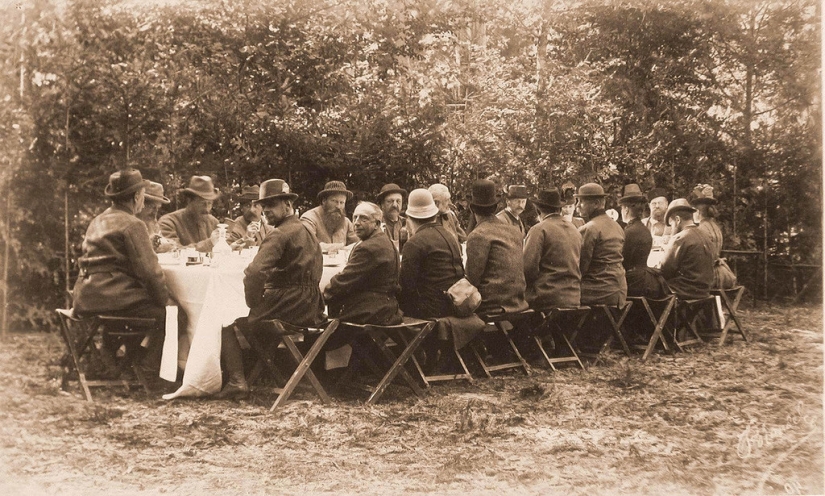
A group of participants of the royal hunt for dinner; on the right — Emperor Alexander III, on his right — Empress Maria Feodorovna; the third from her-the Minister of the imperial court and estates I. I. Vorontsov-Dashkov.
Under such "pressure", the traditions were restored and strictly implemented. While the hunters were getting ready and going out to hunt, becoming "on the numbers", the kitchen attendants had their own worries. A whole train of bulky carriages was leaving for the forest. All this was called the royal kitchen.
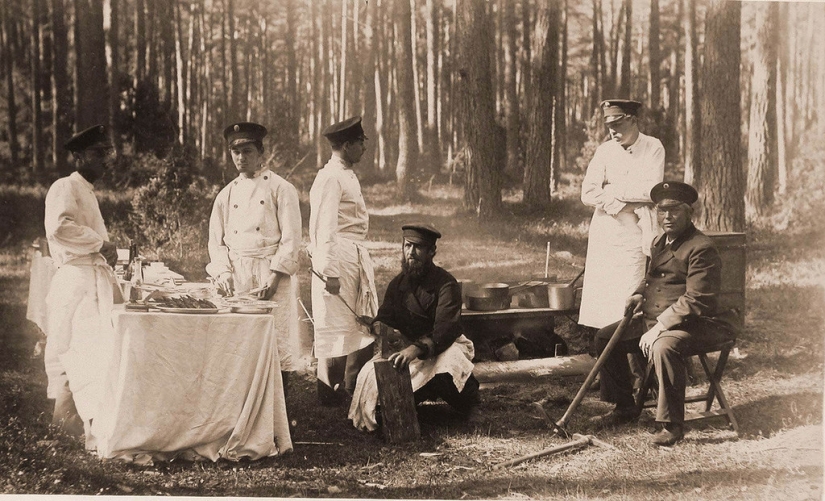
Cooks cooking dinner in the forest during the royal hunt.

Emperor Alexander III (far right), Empress Maria Feodorovna (on his right hand) and participants of the royal hunt during lunch in the forest; far left (in a hat) — Prince V. Baryatinsky.
Keywords: History | Emperor | Russian empire | Tsar | 19th century | Food and drinks
Post News ArticleRecent articles

Extreme gastronomy from different parts of the planet can cause tremors and awe even the most jaded consumer. Canned bread and pork ...

There are people who are able to notice beauty in every little thing around, and this skill they should definitely learn! We offer ...
Related articles

The formation of Russian names occurred centuries under the influence of many factors and cultures. Despite this, our imenoslov ...

Many are tormented by the question — why do some grow long nails on his pinky. If you ask the owners of such "decorations", we ...

May West once jokingly said that she should be given a license to invent sex, which she discovered for Americans. The name of this ...

Every region of the world with a fairly cold winter has its own traditional ways of heating homes. In Western European countries, ...